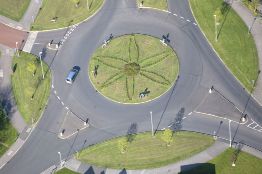Module 4
1. Module 4
1.17. Page 5
Module 4: Area
Lesson Summary

© Ian Bracegirdle/shutterstock
The design of traffic circles must take traffic volume and speed into account, as well as land available for development. If you examine the layout of the circle in the photograph, you will notice that the paved section is a composite figure made up of circles with the same centre but different diameters. How large do you think this traffic circle is, and what area do you think the traffic circle covers?
In this lesson you explored these questions:
- How are the areas of circles calculated?
- How are the areas of composite shapes involving circles determined?
Check your level of understanding of the materials covered in this lesson by completing “Lesson 3 Traffic Lights.” If you select an amber or red traffic light in the multimedia piece, you will receive information about additional work you can complete to improve your understanding of the topics. Complete the suggested work before you proceed to the Lesson 3 Assignment. If you experience difficulty, contact your teacher before starting the Lesson 3 Assignment.
In exploring these questions, you discovered the area formula for the circle, and you applied area formulas to find the areas of composite figures made up of common shapes, including circles.
 Assignment
Assignment
Retrieve the Lesson 3 Assignment Booklet you saved in your course folder at the start of this lesson. Complete the Assignment Booklet. Resave your Assignment Booklet in your course folder and submit a copy to your teacher for assessment.
Unit 2 Project
Before you move on to the next lesson, you should return to the Unit 2 Project and apply the skills of this lesson to the areas you may need to resize.